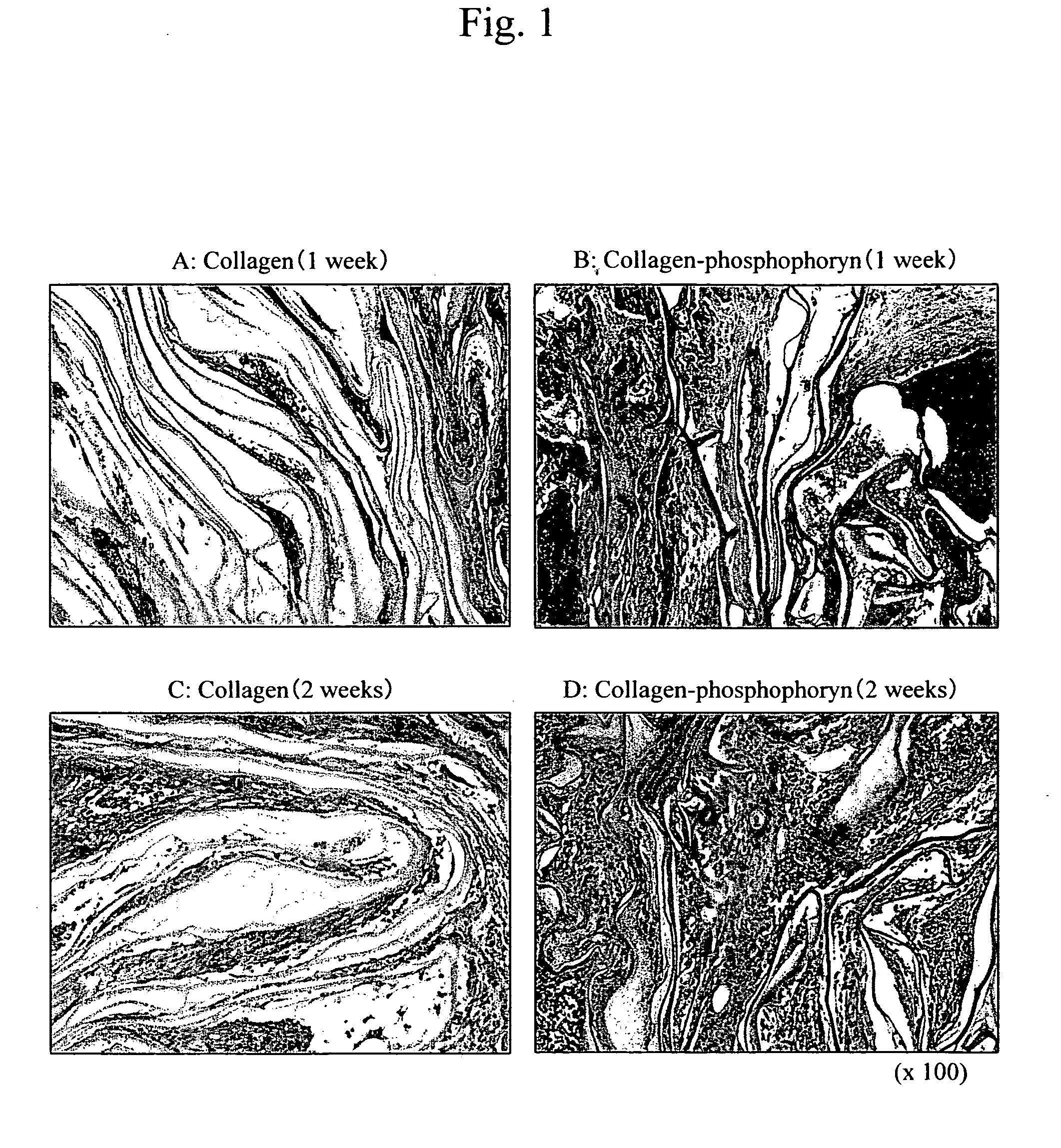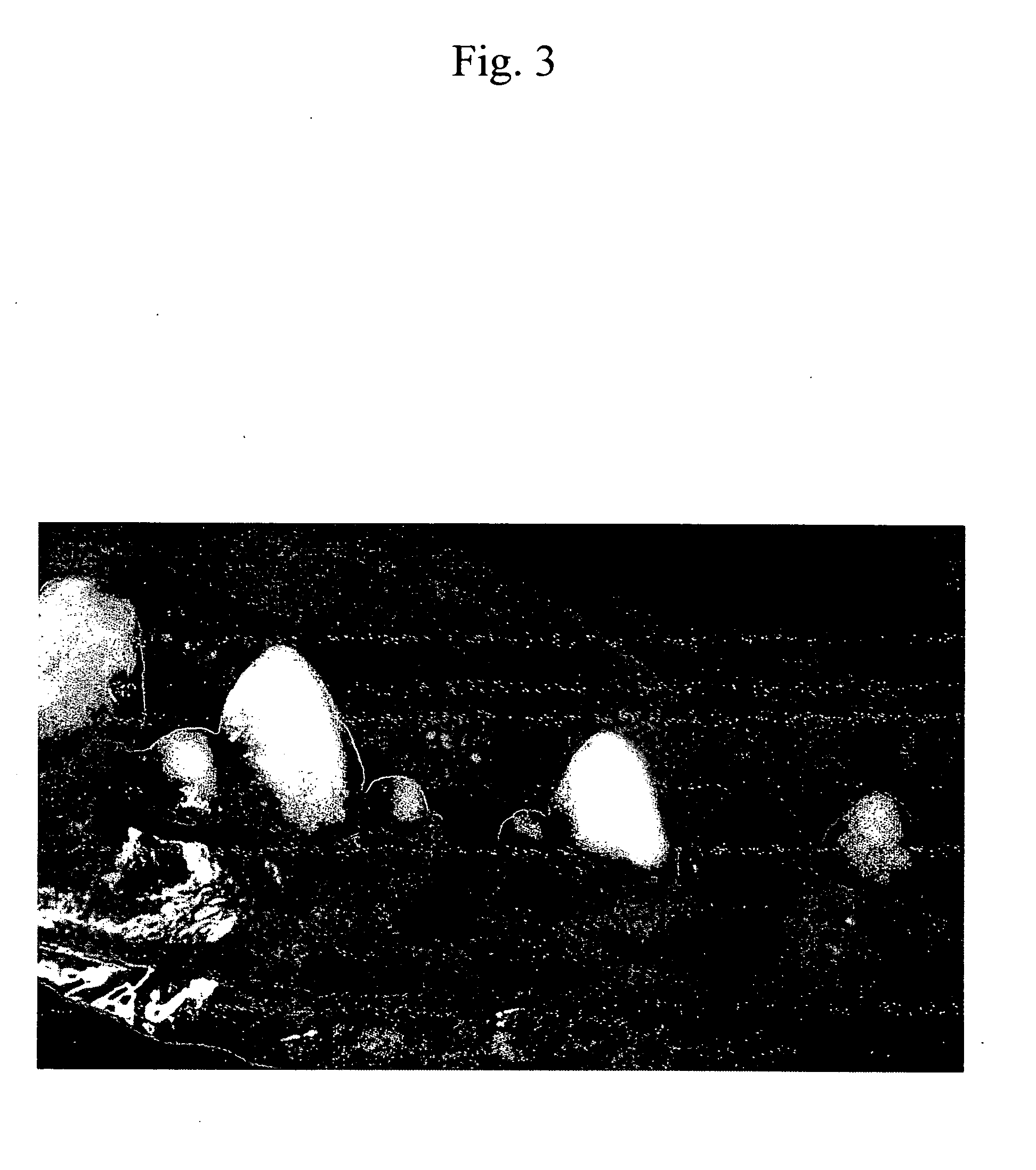Periodontal tissue regeneration using composite materials comprising phosphophoryn
a composite material and periodontal tissue technology, applied in the field of composite materials comprising phosphophoryn and collagen, and to periodontal tissue regeneration, can solve the problems of low bone regeneration inducibility of other materials, unsuitable carrier thereof, and low water soluble content, and achieve the effect of convenient formability and cost-effectiveness
- Summary
- Abstract
- Description
- Claims
- Application Information
AI Technical Summary
Benefits of technology
Problems solved by technology
Method used
Image
Examples
example 1
Production of Composite Biomaterials of Phosphophoryn / Collagen
(1) Purification of Phosphophoryn
[0069] At the outset, permanent teeth were extracted from the bovine lower jaw pyramid, and soft tissues, dental pulp, dental enamel, and dental cement were removed therefrom. The remaining dentin was finely pulverized to 200-mesh or smaller particles in liquid nitrogen. Dentin powder was demineralized using 0.5 M EDTA and 0.05 M Tris-HCl (pH 7.4, containing protease inhibitors: 100 mM 6-aminohexanoic acid (Wako Pure Chemical Industries, Ltd.), 5 mM benzamidine-HCl, and 1 mM phenylmethylsulfonyl fluoride) at 4° C.
[0070] Subsequently, the solution of demineralized EDTA was dialyzed with deionized and distilled water using a dialysis membrane (Spectrum MWCO 3500, 132725) at 4° C. and then lyophilized (Eyela Freeze-Dryer 90500042, Tokyo Rikakikai Co., Ltd.). The EDTA extract was dissolved in 20 mM Tris-HCl (pH 7.4, containing a proteolytic enzyme), and CaCl2 was added thereto to a final c...
example 2
Experiment of Implantation into Rat Femurs
1. Cell Culture
[0078] The femurs of 8-week-old Fischer rats were excised, and cells in the bone marrow were extracted therefrom in accordance with a conventional technique. The extracted cells were cultured for 10 days under the following conditions. During the culture period, media were exchanged every 2 days, suspended hematocytes were removed, and osteoblasts adhering to the bottom were purified.
[0079] Culture conditions: temperature of 37° C.; CO2 level of 5%; α-MEM media (10% FBS+1% glutamine+antibiotics)
[0080] The osteoblasts that had been cultured for 10 days in the manner described above were subcultured (106 cells / ml), and cultured on collagen-phosphophoryn sheets (10 mm φ, 5 sheets) or collagen sheets (10 mm φ, 5 sheets) for 2 weeks under the following conditions.
[0081] Culture conditions: temperature of 37° C.; CO2 level of 5%; α-MEM media (10% FBS+1% glutamine+antibiotics)+10 mM β-glycerophosphate+50 μg / ml of vitamin C phos...
example 3
Experiment of Implantation into Dog Periodontal Tissue
[0087] Six male beagle dogs aged 10 months were used in this study. All surgical procedures were performed under general anesthesia with sodium pentobarbital (40 mg / kg), and local infiltrated anesthesia with 2% lidocaine with 1:80,000 noradrenaline. The lower second, third, and fourth premolars (P2, P3, and P4) in each dogs were selected for experimentation (FIG. 3). After mucoperiosteal flaps were raised(FIG. 4), buccal alveolar bone defects having depth of 5 mm were created surgically(FIG. 5). Denuded root surfaces were prepared to remove all periodontal ligament and cementum. Reference notches were place on roots at the bone level. All four groups of phosphophoryn / collagen complex and collagen alone were placed on alveolar bone defects. Furthermore, no material was implanted as a negative control (FIG. 7,8). The flaps were coronally repositioned and sutured with 4-0 nylon sutures(FIG. 9). One, two and three months after plant...
PUM
| Property | Measurement | Unit |
|---|---|---|
| porosity | aaaaa | aaaaa |
| porosity | aaaaa | aaaaa |
| pH | aaaaa | aaaaa |
Abstract
Description
Claims
Application Information
 Login to View More
Login to View More - R&D
- Intellectual Property
- Life Sciences
- Materials
- Tech Scout
- Unparalleled Data Quality
- Higher Quality Content
- 60% Fewer Hallucinations
Browse by: Latest US Patents, China's latest patents, Technical Efficacy Thesaurus, Application Domain, Technology Topic, Popular Technical Reports.
© 2025 PatSnap. All rights reserved.Legal|Privacy policy|Modern Slavery Act Transparency Statement|Sitemap|About US| Contact US: help@patsnap.com



